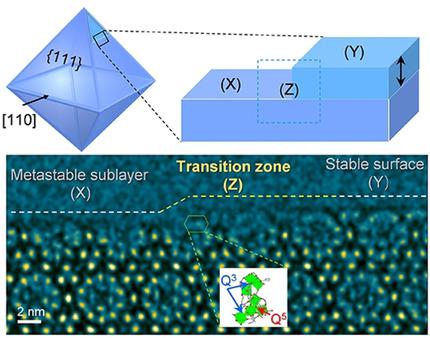当前位置:
X-MOL 学术
›
Angew. Chem. Int. Ed.
›
论文详情
Our official English website, www.x-mol.net, welcomes your feedback! (Note: you will need to create a separate account there.)
Structures and Structural Evolution of Sublayer Surfaces of Metal-Organic Frameworks.
Angewandte Chemie International Edition ( IF 16.6 ) Pub Date : 2020-08-14 , DOI: 10.1002/anie.202008100 Xiaocang Han 1 , Pan Liu 1, 2 , Fang Lin 3 , Wenqian Chen 2, 4 , Ruichun Luo 1 , Qi Han 5 , Zhuo Jiang 5 , Xiaodong Wang 1 , Shuangxi Song 1 , Kolan Madhav Reddy 1, 2 , Hexiang Deng 5 , Mingwei Chen 2, 6
Angewandte Chemie International Edition ( IF 16.6 ) Pub Date : 2020-08-14 , DOI: 10.1002/anie.202008100 Xiaocang Han 1 , Pan Liu 1, 2 , Fang Lin 3 , Wenqian Chen 2, 4 , Ruichun Luo 1 , Qi Han 5 , Zhuo Jiang 5 , Xiaodong Wang 1 , Shuangxi Song 1 , Kolan Madhav Reddy 1, 2 , Hexiang Deng 5 , Mingwei Chen 2, 6
Affiliation

|
The structural characterization of sublayer surfaces of MIL‐101 is reported by low‐dose spherical aberration‐corrected high‐resolution transmission electron microscopy (HRTEM). The state‐of‐the‐art microscopy directly images atomic/molecular configurations in thin crystals from charge density projections, and uncovers the structures of sublayer surfaces and their evolution to stable surfaces regulated by inorganic Cr3(μ3‐O) trimers. This study provides compelling evidence of metal–organic frameworks (MOFs) crystal growth via the assembly of sublayer surfaces and has important implications in understanding the crystal growth and surface‐related properties of MOFs.
中文翻译:

金属有机骨架亚层表面的结构和结构演化。
低剂量球面像差校正高分辨率透射电子显微镜(HRTEM)报告了MIL-101亚层表面的结构特征。国家的最先进的显微镜直接图像从电荷密度突起薄晶体原子/分子构型,并且揭露子层表面的结构和它们的演进到稳定表面由无机铬调节3(μ 3 -O)三聚体。这项研究提供了令人信服的证据,表明通过子层表面的组装可以实现金属有机框架(MOF)晶体的生长,并且对于理解MOF的晶体生长和表面相关特性具有重要意义。
更新日期:2020-08-14
中文翻译:

金属有机骨架亚层表面的结构和结构演化。
低剂量球面像差校正高分辨率透射电子显微镜(HRTEM)报告了MIL-101亚层表面的结构特征。国家的最先进的显微镜直接图像从电荷密度突起薄晶体原子/分子构型,并且揭露子层表面的结构和它们的演进到稳定表面由无机铬调节3(μ 3 -O)三聚体。这项研究提供了令人信服的证据,表明通过子层表面的组装可以实现金属有机框架(MOF)晶体的生长,并且对于理解MOF的晶体生长和表面相关特性具有重要意义。



























 京公网安备 11010802027423号
京公网安备 11010802027423号